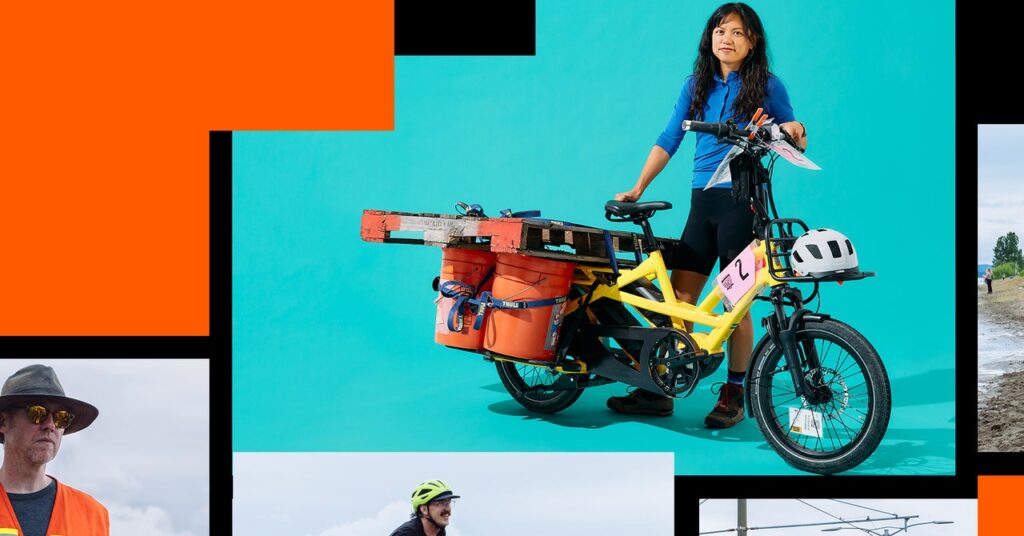When the Big One Hits Portland, Cargo Bikers Will Save You
The Pacific Northwest is due for a massive quake. I trained to help rescue efforts in the aftermath—by racing around the…


But then we had a kid, and after her first birthday we enrolled her in daycare. As I flipped through the parent handbook, skimming the guidelines on nut-free snacks and religious holidays, my eye stopped on page 19: emergency supplies. The instructions told me to pack boxed drinks, diapers, an emergency blanket, a jar of high-protein food, and a plastic poncho, all of which the school would store in a watertight container. The final item was a photograph of our family. “Add an encouraging note!” the handbook suggested.
I gamely found a blank card in my filing cabinet, printed out a picture, and started writing. “Hi baby!” I began, then stopped. What do you say to your toddler in the aftermath of a catastrophe? My daughter’s teachers were going to hand her a photo and a juice box, in the middle of a city in ruins, and tell her everything was going to be OK? Yeah, no. I would inflate a dinghy with my own lungs, I would paddle through flames, I would cross miles of smoking rubble to get to her.
Slowly, I started to make a plan. First, my husband and I had another baby, a son. We moved to a new house within walking distance of our kids’ school. I bought a 50-gallon water barrel. I pinged our neighborhood group chat to keep tabs on who had an emergency generator and vegetable garden. Then my husband—himself a bit of a catastrophist—started to fret that I wasn’t fast enough on my human-powered bike and trailer to pull our two toddlers out of harm’s way. So I bought an electric cargo bike, a cheery yellow Tern GSD S00 that my daughter, then 5, named Popsicle.
I learned about the Disaster Relief Trials from a friend earlier this year. The race is designed to mimic four days of chaos after catastrophe hits. It has the format of an alleycat, a type of unsanctioned street race that bike messengers ride in, with checkpoints all over the city and a laminated map on which race volunteers mark off tasks after they are completed. In the DRT, each of the tasks takes the form of obstacles that people volunteering relief in a disaster might encounter: rough terrain to traverse, rubble to clear, messages to deliver, water to carry. As in a real disaster, we won’t know what the route is or what we need to do until we’re handed our maps an hour before the start.
After the Big One, bridges will collapse. Debris, damaged roads, and a lack of fuel will make it impossible for emergency vehicles to pass. A bike, though, can go almost anywhere. In the decade since it was founded, the DRT has evolved from an event run mostly by pedal punks to a training exercise for the Portland Bureau of Emergency Management. Neighborhood emergency response teams work the race to serve their volunteer hours. As I read the website, I realized that I’d been preparing for this for years. I had a bike; I was ready. I signed up. It was only after a half-dozen people pointed out that I’d be carrying my own body weight in gear that I started to wonder whether I really could be the hero I thought I was.
Photographs: GRITCHELLE FALLESGON
Mike Cobb, the founder of the Disaster Relief Trials, is a former bike mechanic. He got the idea for the race after watching footage of the devastating 2010 Haiti earthquake. Bikes, he thought, could help solve a major transportation problem. After I signed up, I emailed Cobb with the frank admission that I had no idea how to load clunky gear onto my bike. He told me to meet him the following Tuesday in Cully Park, where the race starts and ends, at what he calls his weekly coffee klatch.
When I showed up on Popsicle, Cobb and some former participants were standing around the picnic tables. He offered me a hot coffee and an assortment of about 12 alternative milks. Cobb has unruly dark hair, a grizzled beard, and is lean in a sinewy, rubber-bandy biker way. His sense of humor, I soon learn, is bone-dry. He refers to me, his face completely deadpan, as “the embedded reporter.”




